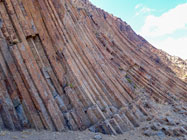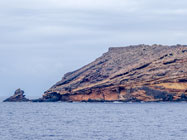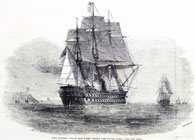|
Home
Page 1/6
Page 2/6
Page 3/6
Page 4/6
Page 5/6 (this page)
Page 6/6

|
Porto Santo, safe harbor
thanks to ice age sand
webpage 5/6
Text: Annemieke van Roekel
Basalt columns
One of the characteristic peaks of Porto Santo is the Pico de Ana Ferreira in the southwest.
Basalt columns ('mugearite') were extracted in an old quarry (fig. 10).
These mining activities determined the shape of the top.
Basalt columns, which filled a crater pipe, are created by shrinkage during the cooling of magma.
The rocks are between 12.7-12.5 million years old. The surrounding rock eroded away, as did most of the
volcanic complex. The quarry is a Geomonument since 2009.
Connected islands
Ilhéu de Baixo, also called Ilhéu da Cal (fig. 11), was connected to Porto Santo until
the Pliocene. From the 18th century onwards, limestone was mined for construction and agriculture.
Although the lime extraction came to a halt about forty years ago, the excavated exploitation
corridors can still be seen. More than 10,000 cubic meters
of limestone (calcarenite) was extracted manually at the Blandy Brothers Mine, in the southern part of the islet
(Gudveig Baarli, 2013). The calarenite, a carbonate variant of sandstone, originates from a 15.2 million-year-old
reef of red algae, located on top of volcanic sediments from the submarine phase.


Fig. 10. Basalt columns in the old quarry at the top of the Pico de Ana Ferreira.
Fig. 11. Ilhéu de Baixo from the east. Photo's: A. van Roekel.
Early geologists
Ilhéu de Baixo was visited by the Victorian geologists Lyell and Hartung, and they were
amazed by the limestone reef located on the tuff (Wyse Jackson, 2007). He quotes:
"At the beginning of January 1854, Lyell and Hartung spent three days on the island of Porto
Santo, thirty miles NE of Madeira, to which they sailed in the British warship HMS St Jean d'Acre through
the kindness of its captain. Porto Santo was a volcanic island, formed much like Madeira by volcanic
eruptions on land. On the small island of Baixo off the west end of Porto Santo, they found a fossil
coral reef, resting on volcanic tuff. Baixo provided clear evidence of the elevation of formerly submarine
volcanic rocks."

Fig. 12. The warship HMS St Jean d'Acre that brought Lyell and Hartung to Porto Santo in 1854.
Public domain.
Page 1/6
Page 2/6
Page 3/6
Page 4/6
Page 5/6
Page 6/6
Top photo: View to Ilhéu de Baixo from Miradouro das Flores.
© A. van Roekel
Copyright: Annemieke van Roekel
Last update: July 25, 2022
|